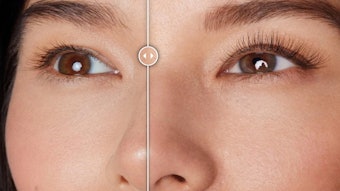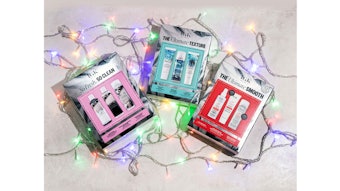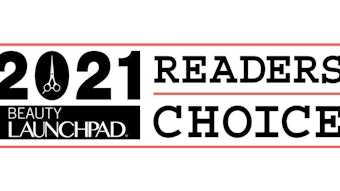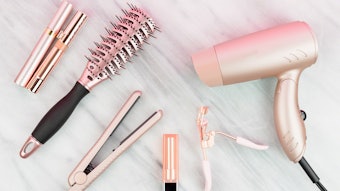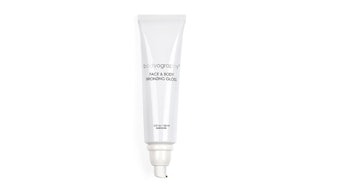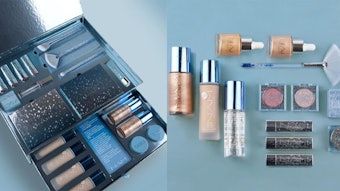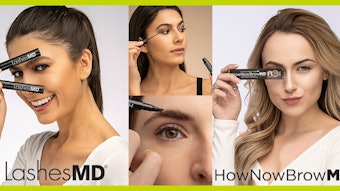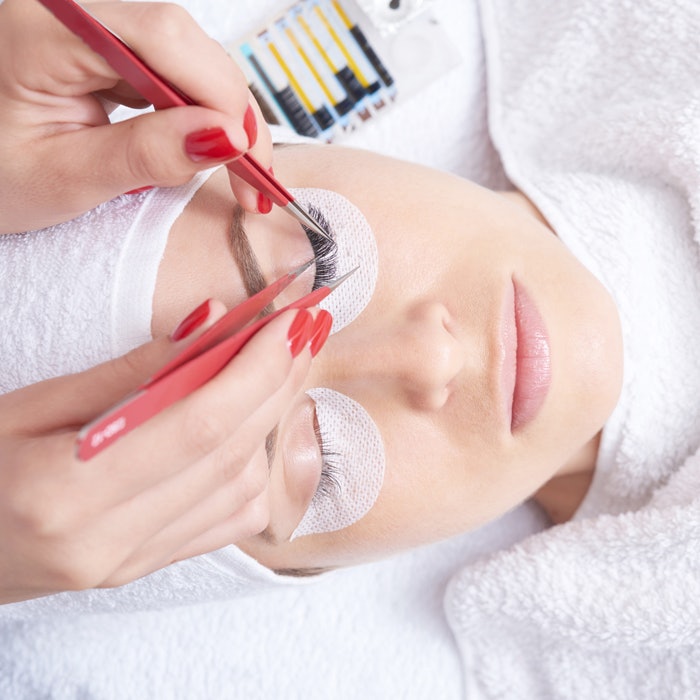
Too much –or not enough– humidity in your lashing room can lead to some sticky situations for cyanoacrylate (CA) adhesives used for lash extensions. Here’s the science: According to Stefani Altieri, medical esthetician and master lash educator for The Lash Shop / StellaLash Academy in Howell, New Jersey, CA is an acrylic resin that rapidly polymerizes in the presence of moisture, forming long, strong chains, joining the bonded surfaces together.
Hence, humidity can affect adhesives’ curing time, potentially preventing effective bonds or retention. “As humidity levels rise, so too does the speed with which the molecular bonds between synthetic extensions and natural eyelashes form,” explains Sophy Merszei, molecular biologist, CEO and founder of Houston- based NovaLash. However, “humidity is relative,” notes Joanne Douglass, a certified NovaLash educator in New Century, Kansas. Yes, CA is more affected by relative humidity than absolute humidity; absolute humidity is defined by the measure of water molecules (vapor) in the air, regardless of temperature and other factors. On the other hand, “[relative humidity] levels are based on temperature, absolute vapor density and saturation vapor density,” explains Douglass. For instance, “a fluctuation in temperature can cause relative humidity levels to rise and fall,” Merszei explains, so you need to factor in temperature too. However, don’t attempt to alter your space’s heating or air-conditioning so much so that your client becomes uncomfortably chilly or overheated. Before overdoing the climate control in an attempt to adjust relative humidity for prime CA bonding, you’ll want to first employ humidifiers or dehumidifiers—and lucky you, we’ve tapped experts who not only break down which type you’ll need to humidity-proof your business, but also offer up a bevy of easily adapted tips to humidity-proof your adhesive results.
RELATED: Understanding Lash Extension Curls and How Each One Functions
Cause and Effect
How exactly does air’s moisture affect adhesives? Generally, Altieri explains, the higher the environment’s relative humidity, the faster the product cures. She recommends 40-percent to 70-percent relative humidity for reliable bonds. However, keep in mind: These numbers can vary a great deal according to the manufacturer (which doesn’t always mean “brand”) as well as the particular formula being used. “If humidity is low (less than 30 percent), setting time can become slow,” Altieri says. “If humidity is too high, a shock polymerization takes place, which provokes a shrinking process of the adhesive layer, leading to less bond strength.”
To be safe, check with the adhesive’s manufacturer for both recommended humidity levels and peak performance test results. Esther Bolkin, director and founder of Glad Lash in Northridge, California, notes that you may use a nanomister or nebulizer in dry environments, but proceed with caution: If the nanomister or nebulizer deposits too much moisture on the lashes, the adhesive can bloom—i.e., white spots form on the edges of the adhesive. However, some formulas bloom more than others, or not at all.
Sydney Farrell, content manager for Lash Affair by J. Paris, lash artist and owner of Dollface Salon in Scottsdale, Arizona, adds that temperatures also affect performance. “Higher temperatures tend to contribute to faster curing; molecules in the adhesive move faster, causing them to bond more quickly,” she explains. This happens because warm air can hold more H20 molecules and these molecules bond faster because they bump into each other more quickly. Not surprisingly, cold air isn’t capable of holding H20 molecules well. So, “conversely, lower temperatures suspend the molecules for a period, preventing polymerization from starting too soon,” Farrell adds.
RELATED: Survey Shows Brow and Lash Artist are Satisfied with Their Work
When looking at peak performance for a CA-based adhesive, Merszei says that any extreme temperature-proof adhesive can be used while working in an environment of high or low moisture levels. “The best quality adhesives not only withstand average, mean or median room temperatures, but are actually designed to have peak performance levels in an even broader range of room temperatures,” she says. “This is one reason why some adhesives develop a cult following, people are willing to pay more and they actually end up saving money at the end of each year. Asking manufacturers questions about peak performance test results is strongly suggested for anyone shopping for eyelash extension adhesives.”
What's Your Type
Regardless of your local weather conditions, having a thermo hygrometer to determine humidity levels and temperature in your lashing area can be helpful, but Amanda Jacobellis, CEO of Makeup Mandy Eyelash Bar and Makeup Studio in Los Angeles and creator of LAshX, warns that these do not read relative humidity, which is what you need to be aware of with CA adhesives. However, knowing what type of climate you’re working in allows you to climate control your area; then, you can talk to your adhesive manufacturer about “the adhesive characteristics and which is best for low, medium or high humidity,” Altieri notes.
RELATED: Industry Experts on the Future of Lash Extensions
When purchasing adhesive, Michelle Mirizio, a NovaLash brand ambassador at Let’s Talk Makeup Salon & Spa in West Palm Beach, Florida, suggests also asking the following questions: What’s the shelf life, both for when the adhesive’s opened and unopened? How should I store the adhesive? Is the adhesive waterproof and/or oil- resistant?
Bolkin believes that stocking one type of glue is sufficient, as long as the working environment is climate controlled. If you tend to travel for either competitions or services, you may wish to have a variety of adhesives on hand in case you can’t control your environment. And Farrell suggests asking manufacturers to send a copy of the adhesive’s Material Safety Data Sheet (MSDS) sheet. “This will let you know what additives have been used to prevent the breakdown of the adhesive and can help you determine which works best for your environment,” she explains.
Making It Last
Smart steps can help prolong the life of your adhesive. Farrell notes that most CA-based adhesives have a shelf life of 12 months unopened, and one month after opening. “Store your adhesive in a cool, dark, dry environment,” she advises. “Never store adhesive in the refrigerator after opening, as the temperature fluctuations can cause condensation within the bottle, [leading to premature polymerization and solidification].”
Bolkin also recommends storing adhesive away from direct sunlight, with the bottle facing up. “Don’t leave off the cap for extended periods of time,” she adds. “Let the adhesive drip out; squeezing the bottle allows additional air to enter.”
Humidity can impact the shelf life of your adhesive, so Altieri suggests storing it in an airtight jar, zip bag or bottle with a package of silica gel. “After removing the cap, press a lint-free wipe or cosmetic sponge over the nozzle and shake vigorously for 30 seconds,” she says. “After using, wipe the nozzle again and close the cap tightly.”
Mirizio recommends avoiding extreme temperature changes and stocking too many bottles to avoid adhesive breakdown. Meanwhile, Andrea Caban, vice president and lead trainer at The Lash & Brow Academy in Encino, California, uses a pushpin to open a new bottle, helping to maximize usage and eliminate any excess air in the container.
Humidity-Proofing Your Business
Mirizio breaks down some tech tools that alter air quality: An air purifier/ cleaner removes contaminants from the air; humidifiers increase humidity, while dehumidifiers reduce humidity; and thermo hygrometers measure moisture content in the atmosphere.
If the workspace air fluctuates often and climate control is, well, out of your immediate control, a thermo hygrometer is a must. “Choose one with a clock to help guide you,” Caban recommends. “If the adhesive dries too fast in high humidity, remove moisture from the air: Run a dehumidifier, or increase the heat or air conditioning [within reason]. To speed up curing time in low humidity, use a facial steamer, humidifier or spray bottle to add moisture.” Altieri suggests a dehumidifier if the environment is consistently above 66-percent humidity, or a whole- room humidifier if lower than 35 percent.
Chanel Baring, owner and founder of San Francisco-based Sass and certified Lash Affair trainer, uses a dehumidifier when humidity reaches over 50 percent. She places the dehumidifier to the right of her worktable, then turns it on until the humidity reaches 40 percent, her preferred level. Conversely, Farrell, who works in a dry climate, turns on a humidifier to reach 35 percent to 45 percent. Of course, you’ll have to find your own sweet spot, but these tools will help you get there!
5 Pro Retention Tips
Farrell recommends the following pointers to ensure tip-top retention in any climate:
- Replenish your adhesive dot when it becomes too dry to spread.
- Dip your lash in the center of the glue dot—never drag out horizontally, double-dip or wipe off excess adhesive on the gel pad if it has started setting even the slightest bit.
- It’s acceptable to have enough adhesive on the extension so that it forms tiny beads, but they must be smoothed out well.
- In a very dry environment, dip the lash in slowly and remove slowly, ensuring that enough adhesive is on the extension so it bonds well.
- Never use more than a 2mm drop of adhesive.
Trouble Shooting Tips
Farrell helps troubleshoot your humidity-related concerns.
Isuue: When brushing through the lashes, they pop off, or the extension isn’t sticking on the natural lash.
Culprit: High humidity and temperature, causing the adhesive to cure too quickly.
Solution: Use more adhesive to properly bond the extension to the natural lash. Isolate properly to avoid multiple natural lashes from being bonded together.
Issue: The extension falls over once placed on the natural lash, or the lashes stick together.
Culprit: Low humidity and temperature, causing the adhesive to cure slowly.
Solution: Use less adhesive and/or use a humidifier or nanomister during the service. Or take two cotton rounds, saturate with water and wring out. Fold in half and put the damp half-circles on the client’s cheekbones, which bumps up moisture to help the adhesive cure quickly.

